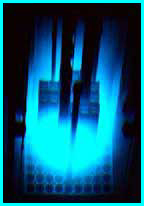Cherenkov effect
|
|

Cherenkov radiation (also spelled Cerenkov) is electromagnetic radiation emitted when a charged particle passes through an insulator at a speed greater than that of light in the medium. The characteristic "blue glow" of nuclear reactors is due to Cherenkov radiation. It is named after Pavel Alekseyevich Cherenkov, the 1958 Nobel Prize winner who was the first to rigorously characterize it.
| Contents |
Physical origin
While relativity holds that the speed of light in a vacuum is a universal constant (c), the speed of light in a material may be significantly less than c. For example, the speed of light in water is only 0.75c. Matter can be accelerated beyond this speed during nuclear reactions and in particle accelerators. Cherenkov radiation results when a charged particle, most commonly an electron, exceeds the speed of light in a dielectric medium through which it passes.
Moreover, the velocity of light that must be exceeded is the phase velocity rather than the group velocity. The phase velocity can be altered dramatically by employing a periodic medium, and in that case one can even achieve Cherenkov radiation with no minimum particle velocity — a phenomenon known as the Smith-Purcell effect. In a more complex periodic medium, such as a photonic crystal, one can also obtain a variety of other anomalous Cherenkov effects, such as radiation in a backwards direction (whereas ordinary Cherenkov radiation forms an acute angle with the particle velocity).
As a charged particle travels, it disrupts the local electromagnetic field in its medium. Electrons in the atoms of the medium will be displaced and polarized by the passing EM field of a charged particle. Photons are emitted as an insulator's electrons restore themselves to equilibrium after the disruption has passed. (In a conductor, the EM disruption can be restored without emitting a photon.) In normal circumstances, these photons destructively interfere with each other and no radiation is detected. However, when the disruption travels faster than the photons themselves travel, the photons constructively interfere and intensify the observed radiation.
A common analogy is the sonic boom of a supersonic aircraft or bullet. The sound waves generated by the supersonic body do not move fast enough to get out of the way of the body itself. Hence, the waves "stack up" and form a shock front. Similarly, a speed boat generates a large bow shock because it travels faster than waves can move on the surface of the water.
In the same way, a superluminal charged particle generates a photonic shockwave as it travels through an insulator.
Cherenkov.png
In the figure, v is the velocity of the particle (red arrow), β is v/c, n is the refractive index of the medium. The blue arrows are photons. So:<math>\cos \varphi=\frac1{n\beta}<math>
Characteristics
Intuitively, the overall intensity of Cherenkov radiation is proportional to the velocity of the inciting charged particle and to the number of such particles. Unlike fluorescence or emission spectra that have characteristic spectral peaks, Cherenkov radiation is continuous. The relative intensity of one frequency is proportional to the frequency. That is, higher frequencies (shorter wavelengths) are more intense in Cherenkov radiation. This is why visible Cherenkov radiation is observed to be brilliant blue. In fact, most Cherenkov radiation is in the ultraviolet spectrum - it is only with sufficiently accelerated charges that it even becomes visible; the sensitivity of the human eye peaks at green, and is very low in the violet portion of the spectrum.
As in sonic booms and bow shocks, the angle of the shock cone is inversely related to the velocity of the disruption. Hence, observed angles of incidence can be used to compute the direction and speed of a Cherenkov radiation producing charge.
Uses
Cherenkov radiation is used to detect high-energy charged particles. In pool-type nuclear reactors, the intensity of Cherenkov radiation is related to the frequency of the fission events that produce high-energy electrons, and hence is a measure of the intensity of the reaction. Cherenkov radiation is also used to characterize the remaining radioactivity of spent fuel rods.
When a high-energy cosmic ray interacts with the Earth's atmosphere, it may produce an electron-positron pair with enormous velocities. The Cherenkov radiation from these charged particles is used to determine the source and intensity of the cosmic ray, which is used for example in the Imaging Atmospheric Cherenkov Technique (IACT), by experiments such as H.E.S.S. and MAGIC. Similar methods are used in very large neutrino detectors, such as the Super-Kamiokande.
Notes
- Cherenkov effect image provided by and © the Nuclear Engineering Department (http://www.nuc.umr.edu/index.html) of the University of Missouri-Rolla (http://www.umr.edu/); used by kind permission of Dr. Akira T. Tokuhiro. See http://www.nuc.umr.edu/reactor/reactor.html for the original context.
References
- L. D. Landau, E. M. Liftshitz, and L. P. Pitaevskii, Electrodynamics of Continuous Media (Pergamon: New York, 1984).
- J. V. Jelly, Cerenkov Radiation and Its Applications (Pergamon: London, 1958).
- S. J. Smith and E. M. Purcell, Phys. Rev. 92, 1069 (1953).
- Chiyan Luo, Mihai Ibanescu, Steven G. Johnson, and J. D. Joannopoulos, "Cerenkov Radiation in Photonic Crystals," Science 299, 368–371 (2003).de:Tscherenkow-Licht
fr:Effet Tcherenkov fi:Tšerenkovin säteily hu:Cserenkov-effektus ja:チェレンコフ放射 pl:Promieniowanie Czerenkowa pt:Radiação de Cerenkov ru:Эффект Черенкова sl:Pojav Čerenkova
